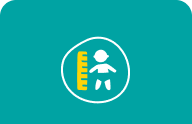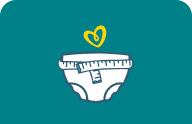Your 15-Month-Old’s Development and Milestones
At 15 months old, your toddler is becoming better and more confident at walking and other types of independent movement. Besides cheering them on, your role is to help keep your child safe as they explore. Little by little, you’re getting glimpses of your little one’s temperament and behavior: They may be easygoing in most situations, or they may react with tantrums. They may tend to be active and assertive when you play together, or they may be reserved and prefer to play quietly by themselves. No matter what it is, you’ll love seeing your little one’s personality and style become more apparent this month.
Toddler Development Milestones
As every child is unique, the timing of development milestones and the way they’re achieved may be different from one toddler to another. Remember that every child progresses at their own pace and be patient if some milestones are achieved a little later than others. Here are examples of some of the developmental milestones you may see with your 15-month-old this month:
Slower growth. At 15 months old, your toddler may not be growing as rapidly as they did in their first 12 months. You may notice that their height and weight increase at a slower but steady rate, and that your toddler’s head circumference growth also slows down around this time. Your toddler’s healthcare provider will continue to track growth and weight at regular checkups using the growth charts you may be familiar with from previous visits. By the way, it might interest you to know that your little one’s next big growth spurt will most likely be when they reach adolescence.
Climbing attempts. If your child has been walking for a while, they’ve likely gotten quite good at it, and might be ready for a new challenge—the stairs. Climbing up is the first stage of the process, and they’ll be eager to practice, with you closely watching. Coming down is harder, and you may need to show them how to position themselves to do this safely going backward. Make sure you keep the stairs gated to prevent any solo attempts!
Temperament on display. Your toddler’s temperament is something that is individual to them, and it’s not something that can be changed. As a parent, you can support your child by providing love and encouragement and by being there for them when they feel unsure. For example, if your toddler is showing signs of separation anxiety at certain times of the day like bedtime, it may help to do things like leaving a night-light on or letting them sleep with a favorite blankie.
Understanding how objects function. As your toddler gets to know the world around them, they’ll begin to understand how certain objects function, an important step in cognitive development. You might see that your child starts to use some things as they’re intended—even if not quite successfully. For example, they may run a comb through their hair or hold a telephone to the side of their face. These moments are sure to put a smile on your face as you see your little one connecting the dots.
If you’re wondering whether your toddler’s development is on track, the 15-month checkup is a great time to consult your child’s healthcare provider about it.
Activities for Supporting Your 15-Month-Old Toddler’s Development
Are you searching for learning activities to do with a 15-month-old? Here are some ways to support and encourage your toddler’s development:
Reinforce language leaps and boost vocabulary. Around this time, as your toddler is starting to get a grasp of language, they may have their own made-up vocabulary, using substitutes for some words. For example, they may say something like “wa-wa” for water. Although these words are cute to hear, help your child learn the correct words by reinforcing correct pronunciation without poking fun at your little one’s attempts to say the word. A good tip is to wait until they’re finished with what they’re saying, and then follow up by correcting the pronunciation. Your child’s language skills will improve over time with your help. And don’t get hung up on how many words a 15-month-old “should” say as every child learns at their own pace.
Play with your toddler. Join them on the floor during playtime activities and take the opportunity to enjoy quality time together every day. Help them build something with blocks or chant a nursery rhyme that has hand gestures. Even when you’re having a busy day, you might find you enjoy these sessions as much as your toddler does!
Read together every day. Reading with your toddler is just about the best way to foster language development and early literacy, and it’s also a lovely way to spend one-on-one time each day. Bedtime is a particularly good time to read with your little one as it can help them unwind and get into a sleep routine. Go ahead and let your little one choose the book they’d like to read and encourage them to interact and pronounce some of the words on the pages. Even if they’re not quite there yet, encouraging your toddler will prompt them to try. Feel free to elaborate on the story and add some extra elements to make it even more fun for your little one, for example, “Look at the cat—he’s wearing a hat.”
Mealtimes and Menus for Your 15-Month-Old
Three small meals and two snacks each day are a good plan for feeding a 15-month-old. Don’t worry, though, if your toddler eats everything in sight one day while rejecting some foods or even entire meals the next day. These differences in appetite may be the natural result of things like changing activity levels, changes in metabolism, and growth spurts. Don’t take it to heart if your toddler doesn’t want to eat the food you’ve prepared for them. If your toddler’s not eating their lunch, for example, save it for later when they may change their mind and gladly eat it. To ensure they’re getting all the nutrients they need, offer a variety of healthy foods at each mealtime, including:
Proteins like meat, fish, poultry, and eggs
Dairy like cow’s milk and yogurt
Fruits and vegetables
Grains and starches like cereal, bread, pasta, potatoes, and rice.
Keep in mind that, although your little one may not consume a variety of nutritious foods on one day, over the course of a few days their diet will balance out overall, and they’ll get the nutrients they need to grow and stay healthy. If you’re trying to come up with food and meal ideas for your 15-month-old, check out these healthy snack options and nutritious lunch menus for inspiration.
Your 15-Month-Old Toddler’s Sleep Schedule
Sleep is important for your toddler’s health and optimal development. Wondering how much sleep a 15-month-old needs? Your toddler will do well with about 12 to 14 hours of sleep per day, which includes 1 or 2 daytime naps. To help ensure that your toddler is getting enough sleep, create a regular bedtime routine. Here are some guidelines:
Stick to the clock. Try to keep bedtime and naptimes the same every day. That way, your 15-month-old is more likely to feel sleepy when the time for sleep rolls around.
Have some quiet time. Winding things down and avoiding exciting play just before bed can help your little one prepare for sleep. Story time, relaxing music, and a warm bath for your toddler are all good examples of relaxing things to do before for bedtime.
Let your toddler have a "lovey." It’s OK for your child to sleep with a stuffed animal or blankie if they find it comforting. These transitional objects can help your child fall asleep more easily and help them comfort themselves if they wake during the night.
Provide a little light. You may consider having a night-light for your toddler or leaving the bedroom door slightly ajar so that the room isn’t pitch black.
Wait before responding. In the middle of the night, if your child calls for you or cries a little, you might wait for a short time before answering. Then, you might like to check that they’re OK and reassure them from the doorway instead of picking them up or turning on the bedroom light. Briefly and quietly remind them that it’s time to sleep. Of course, if you suspect your child may be ill, you should tend to their needs.
Be patient. It takes a while for your toddler to establish good sleep habits, and it’s normal for your toddler to wake up in the night from time to time. Stay encouraging and try to avoid responding to your child’s needs in a negative way. This will help them learn that they can trust you to be there when they really need it, and knowing this will help your little one feel more comfortable about self-soothing and falling back to sleep on their own.
To help you keep track of your 15-month-old’s nap and sleep schedule, download the Smart Sleep Coach app by Pampers. Cocreated by pediatricians and sleep experts, this app can make it easier to keep to a bedtime routine, assist with sleep training, and help you deal with sleep regression if it arises.
A Day in the Life of Your 15-Month-Old Toddler
Here’s an idea of what a day with your toddler might look like in your home:
Your Toddler’s Health and Safety: Teething and Brushing
Teething is a natural part of your toddler’s development, even if it’s not always comfortable. To help your 15-month-old with any discomfort they’re experiencing with teething, you can gently massage their gums with your finger, or offer a teething ring that they can chew on. Don’t use any type of teething gel or other topical medication to reduce the discomfort of teething. It won’t stay on your toddler’s gums for very long and it may be harmful if they swallow too much of it. Sometimes teething may cause a low-grade fever of no more than 101 degrees Fahrenheit. If your toddler has a fever higher than that, it’s probably not linked to teething and it’s a good idea to contact their healthcare provider. Continue teaching your child about good oral hygiene habits, including brushing their teeth twice a day. To help make this less of a chore for your toddler, you could sing a song or play some music on your phone while they brush. You could also let them choose a fun child’s toothbrush with bright colors or characters on it, or surprise them with a cute cup for rinsing. Although your little one won’t be able to brush their teeth successfully on their own until they’re about 7 years old, establishing the routine early in life sets your child up for great lifelong habits and ensures their teeth and gums are well taken care of. As a reminder, use a soft-bristled children’s toothbrush with a tiny drop of fluoride toothpaste (about the size of a grain of rice) to brush your toddler’s teeth. It’s recommended to brush their teeth after breakfast and before bedtime.
Development Tips for Your Toddler This Month
Consider the following tips for encouraging your 15-month-old toddler’s development as well as keeping them safe:
Offer warm physical contact. Hugs and skin-to-skin contact are more than just warm bonding moments for you and your child; they can do a lot for your toddler’s sense of security when offered on a consistent basis. Hug them often and spend time cuddling regularly—for example, during bedtime stories.
Be sensitive to your child's personality and moods. Every child is unique and different from another, and each one has their distinct rhythm and moods. Be supportive of your 15-month-old’s temperament, and, if needed, use appropriate discipline without yelling or hitting. Being consistent with your actions and reactions is key!
Establish routines. Everyone thrives on routines, especially young children, who need the framework in their young lives. Consistency and predictability can help them keep their expectations in check. Try to keep your 15-month-old’s schedule the same every day. If certain days diverge from the norm (for example, a day at the grandparents’ or a family vacation), that’s OK; just go back to your child’s routine as soon as possible. Sometimes, even the slightest divergence from a daily routine can result in your child waking up at night.
Choose toys that inspire creativity. You don’t have to get your 15-month-old the latest and greatest toy on the market, as sometimes the best toys for toddlers are the simplest, such as a wooden pull toy, a set of blocks, or a toddler-level jigsaw puzzle. These do more for encouraging creativity and imagination than a complicated toy with all the bells and whistles.
Set clear safety rules. The more active your toddler gets, the more you’ll need to be cognizant of setting ground rules for safety around the home. It’s a good to briefly describe the dangers behind the rules, like staying away from the stove when someone is cooking to avoid being burned, or not jumping on the sofa to avoid falling off, etc.
Items You Will Need This Month
Here’s a list of baby gear and products that may be helpful for your child:
Teething ring. Your toddler may be sprouting baby teeth and feeling uncomfortable. A teether can help soothe and distract them. Just make sure to look for something that's nontoxic, made of firm rubber without any gel filling, and isn’t attached to a string or a necklace, which can lead to choking or strangulation.
Night-light. Your child is getting to the age where monsters in the closet may be a concern, and a pitch-black room may be too scary for your little one. Consider getting a night-light with cutouts of the moon and stars or another appealing motif.
Baby gates. Now that your toddler may be going up and down stairs, baby gates are a good idea to make sure your little climber stays safe and doesn't attempt the stairs without your supervision.
Toddler car seat. It’s about time to check your current car seat to see if it meets your toddler’s needs. If your car seat isn’t a convertible model, you may need to upgrade to a toddler car seat. Check your current car seat’s guidelines for height and weight limits.
Children’s books. Reading is an activity you won’t want to give up any time soon. It’s more than just a learning activity—it builds a lasting bond with your little one. Your toddler is now old enough to choose the book they want to read. So, go ahead and offer them a selection, which could include some of your favorite childhood books or some more recent titles. A trip to the library or your local bookstore is always fun!
Diapers, wipes, and diaper rash cream. Keep stocking up on diapers and wipes, and don’t forget to have some diaper rash cream handy just in case.
Your Life as a Parent: Caring for a Sick Child
It’s inevitable that from time to time your child may come down with a cold or some other common childhood illness. Aside from the worry of caring for your sick little one, you may also have to rearrange your days while your toddler is feeling unwell. If your child is ill at day care, you may get a call from the facility letting you know that they need to be sent home. If you can’t get there, you may have to arrange for someone to pick up your child or leave work early, if you can. It’s a good idea to keep your child home until they’re better so they don’t spread germs to the other children at the day care center. Your child’s healthcare provider will be able to advise on when your child may be well enough to return. You or your partner may consider working from home during this time, if that's possible. If you can’t stay home, consider finding a family member or babysitter who can step in to help watch and take care of your child. When your child doesn’t feel well, they may struggle to sleep at night, so you may be up through the night and be more tired during the day. Now might be a good time to reach out for help from the grandparents or a babysitter so that you have the support you need. Caring for your sick child isn’t always easy, but don’t be afraid to ask for help, and contact their healthcare provider if their condition doesn’t improve. With most common illnesses like a mild cold or a sore throat, things should resolve within a few days and life will soon get back to normal.
Checklist for This Month
Schedule your child’s next well-child checkup. If you don’t already have a time set up for your 15-month-old’s well-child checkup, make an appointment soon. In line with the standard child immunization schedule, your child’s healthcare provider may give some vaccinations during this visit.
Check that your toddler is within the height and weight limits of their car seat. You may need to upgrade to a toddler car seat if your little one has outgrown their existing car seat, which means they’re no longer within the height and weight limits specified by the manufacturer. Remember that it’s important to keep the car seat in the rear-facing position until your child is 2 years old.
Acquaint your toddler with a babysitter. At some point, you may need to introduce a new babysitter to your toddler, and you may want to start the search sooner rather than later. When you interview potential babysitters, keep your toddler by you or on your lap, and watch for signs that they’re comfortable with the new person. Then, gradually have the babysitter come closer so you can gauge how they interact. You may even leave the room for a moment to test your toddler’s reaction. Whomever you choose, it’s important that this person has experience caring with young children, comes with good references, knows CPR, and has taken a babysitter safety course.
Take your toddler shopping for shoes. As your little one gets more and more active, including walking more outside, it’s a good idea to check that they have shoes that fit properly. If you can, have your child’s shoe size measured at the store. Look for shoes that feature nonskid soles, like sneakers. Whatever style you choose, it’s worth knowing that little one will most likely outgrow them in a matter of months.
Go clothes shopping for the next size up. It makes sense to be prepared for when your toddler outgrows their current wardrobe. Take advantage of any clothing sales or clearances that may be happening this month to stock up on clothes your toddler may need in the near future. Alternatively, take some time to hunt for hand-me-downs from your older children that you already have at home. You could even organize a clothes swap with parents in your community to stock up on clothes your little one will need in the future and share the clothes that no longer fit your toddler.
For even more information, sign up to get our regular emails:
How We Wrote This Article The information in this article is based on the expert advice found in trusted medical and government sources, such as the American Academy of Pediatrics and the American College of Obstetricians and Gynecologists. You can find a full list of sources used for this article below. The content on this page should not replace professional medical advice. Always consult medical professionals for full diagnosis and treatment.











